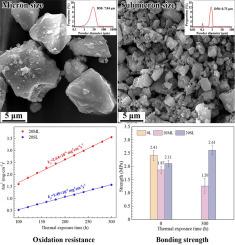利用亚微米级低熔点玻璃粉提高高温有机硅复合涂层的结合强度和抗氧化性
IF 14.3
1区 材料科学
Q1 MATERIALS SCIENCE, MULTIDISCIPLINARY
引用次数: 0
摘要
本研究对比研究了微米级低熔玻璃粉和亚微米级低熔玻璃粉对高温有机硅复合涂层结合强度和抗氧化性能的影响。与微米级LMG粉末相比,亚微米级LMG粉末降低了孔隙率,提高了涂层的结构完整性和内聚强度。在高温下,硅树脂的热氧化分解在涂层内产生许多空腔。在650°C时,LMG粉末发生粘度软化,转变为粘性流动状态。在毛细力作用下,黏性LMG相先向周围空腔浸润,然后聚并。亚微米级LMG粉末在涂层内的均匀分布促进了均匀LMG相的形成,从而对氧气的进入建立了阻隔作用。因此,在650℃下,由亚微米LMG粉末、Al片和其他耐热颜料配制的有机硅复合涂层表现出优异的抗氧化性能。此外,由于玻璃网络形成的共价键的键能比分解后的有机硅树脂形成的二级键的键能更高,含亚微米LMG粉末涂层的内聚强度从2.11 MPa提高到2.61 MPa。本文章由计算机程序翻译,如有差异,请以英文原文为准。

Enhancing bonding strength and oxidation resistance of high-temperature silicone composite coatings using submicron low-melting glass powder
This study comparatively investigated the influence of micron low-melting glass (LMG) powder and submicron LMG powder on the bonding strength and oxidation resistance of high-temperature silicone composite coatings. Compared with the micron counterpart, submicron LMG powder reduced porosity, enhancing the structural integrity and cohesive strength of the coating. At high temperatures, the thermo-oxidative decomposition of silicone resin generated numerous cavities within the coating. At 650 °C, LMG powder underwent viscosity softening, transitioning into a viscous flow regime. Under capillary forces, the viscous LMG phase infiltrated surrounding cavities, followed by coalescence. The uniform distribution of submicron LMG powder within the coating promoted the formation of a homogeneous LMG phase, thereby establishing a barrier effect on oxygen ingress. Hence, at 650 °C, the silicone composite coating formulated with submicron LMG powder, Al flakes and other heat-resistant pigments exhibited superior oxidation resistance. Moreover, owing to the higher bond energy of covalent bonds formed by the glass network compared to the secondary bonds formed by the decomposed silicone resin, the cohesive strength of the coating containing submicron LMG powder increased from 2.11 MPa to 2.61 MPa.
求助全文
通过发布文献求助,成功后即可免费获取论文全文。
去求助
来源期刊

Journal of Materials Science & Technology
工程技术-材料科学:综合
CiteScore
20.00
自引率
11.00%
发文量
995
审稿时长
13 days
期刊介绍:
Journal of Materials Science & Technology strives to promote global collaboration in the field of materials science and technology. It primarily publishes original research papers, invited review articles, letters, research notes, and summaries of scientific achievements. The journal covers a wide range of materials science and technology topics, including metallic materials, inorganic nonmetallic materials, and composite materials.
 求助内容:
求助内容: 应助结果提醒方式:
应助结果提醒方式:


